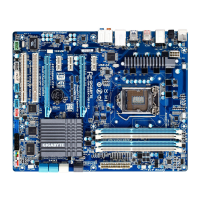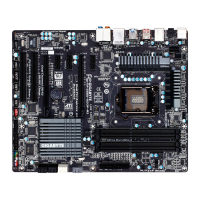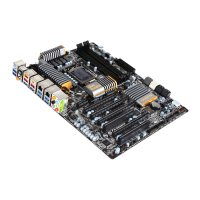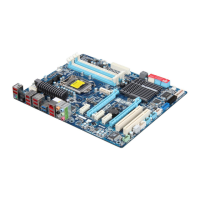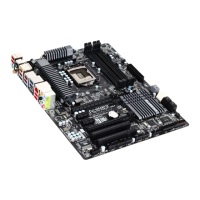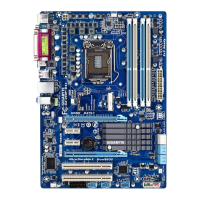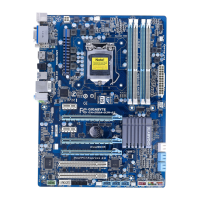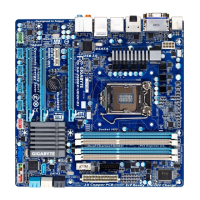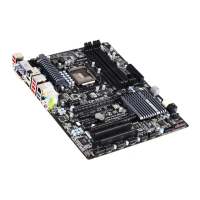
Do you have a question about the Gigabyte GA-Z68X-UD3H-B3 and is the answer not in the manual?
| ECC | No |
|---|---|
| Non-ECC | Yes |
| Memory voltage | 1.5 V |
| Memory channels | Dual-channel |
| Number of memory slots | 4 |
| Maximum internal memory | 32 GB |
| Supported memory clock speeds | 1066, 1200, 1300, 1333, 1600, 1800, 1866, 2133 MHz |
| System bus rate | 5 GT/s |
| Processor socket | LGA 1155 (Socket H2) |
| Processor manufacturer | Intel |
| Compatible processor series | Intel Core i3, Intel Core i5, Intel Core i7 |
| Number of SATA II connectors | 3 |
| Number of Parallel ATA connectors | 0 |
| Headphone outputs | 6 |
| USB 2.0 ports quantity | USB 2.0 ports have a data transmission speed of 480 Mbps, and are backwards compatible with USB 1.1 ports. You can connect all kinds of peripheral devices to them. |
| Audio chip | Realtek ALC889 |
| Component for | PC |
| Motherboard chipset | Intel Z68 |
| Audio output channels | 7.1 channels |
| Motherboard form factor | ATX |
| Compatible operating systems | Windows 7/Vista/XP |
| PCI Express slots version | 2.0 |
| Maximum graphics card memory | 1759 MB |
| RAID levels | 0, 1, 5, 10 |
| LAN controller | Realtek RTL8111E |
| Networking features | 10/100/1000 Mbit/sec |
| Ethernet interface type | Gigabit Ethernet |
| BIOS type | AWARD |
| ACPI version | 1.0b |
| BIOS memory size | 64 Mbit |
| Depth | 244 mm |
|---|---|
| Width | 305 mm |
Details copyright, trademark, and disclaimer information for the manual.
Explains the types of documentation provided by GIGABYTE for product use.
Guides users on how to find the motherboard's revision number.
Lists the items included in the motherboard package.
Lists optional accessories that can be purchased separately.
Diagram showing the physical arrangement of components on the motherboard.
Diagram illustrating the internal connections and data flow of motherboard components.
Essential safety guidelines and precautions before installing hardware components.
Detailed technical specifications of the motherboard and its components.
Step-by-step guide for installing the CPU into the motherboard socket.
Instructions for correctly installing the CPU cooler onto the motherboard.
Guide for installing RAM modules into the motherboard memory sockets.
Explanation of dual channel memory technology and socket configurations.
Detailed steps for correctly inserting memory modules into the sockets.
Procedure for installing expansion cards into PCI Express or PCI slots.
Guide for setting up multi-graphics card configurations like CrossFireX and SLI.
Description and function of all external ports on the motherboard's back panel.
Details on various internal headers and connectors on the motherboard.
Describes the screens that appear during the computer's boot-up process.
Overview of the primary BIOS setup menu and navigation options.
Settings for CPU and memory overclocking, frequency, and voltage adjustments.
Configuration options for various system voltage adjustments.
Configuration for less common BIOS features like Isochronous Support.
Settings for system date, time, and basic hardware configuration.
Advanced boot options, device priority, and system security settings.
Configuration for onboard devices like SATA, USB, Audio, and LAN.
Settings related to ACPI sleep states and power-saving functions.
Monitoring of system voltages, temperatures, and fan speeds.
Option to load the safest, most stable BIOS default settings.
Option to load the BIOS settings for optimal performance.
Procedure for setting or disabling BIOS supervisor and user passwords.
Saves BIOS configuration changes and exits the setup utility.
Exits BIOS setup without saving any changes made.
Guide for installing essential chipset drivers from the motherboard disk.
Lists GIGABYTE utilities and free software available on the driver disk.
Provides access to application guides and motherboard manuals.
Provides contact details for GIGABYTE support and website links.
Displays basic system information about the installed hardware.
Links to GIGABYTE's website for the latest BIOS, drivers, and applications.
Provides quick links to install GIGABYTE's recently developed utilities.
Tool for quick system backup and restoration, supporting NTFS, FAT32, FAT16.
Overview of GIGABYTE's BIOS update tools: Q-Flash and @BIOS.
Instructions for updating the system BIOS using the Q-Flash utility.
Guide for updating the system BIOS using the Windows-based @BIOS utility.
Software for fine-tuning system settings, overclocking, and monitoring.
Technology for power savings and enhanced power efficiency via button click.
Easy tool for data sharing with computers on the same network.
Combination of 6 utilities for system management: QuickBoot, DualBIOS, etc.
Utility to back up partitions as image files hourly for system restoration.
Feature to record personal passwords and important dates, storing them in BIOS.
Monitors system activities and manages computer usage time with rules.
Tool to enable system power savings via Bluetooth cell phone proximity.
Utility for configuring RAID-ready systems and enhancing drive performance.
Overclocking utility for system tweaking via Internet-connected devices.
Steps to install and configure SATA hard drives and RAID arrays.
Guide for setting up SATA controller modes and RAID for Intel Z68 chipset.
Detailed steps for creating and managing RAID arrays using Intel BIOS utility.
Procedure for setting up recovery volumes for data protection and restoration.
Instructions for deleting existing RAID arrays and resetting disks.
Guide for setting up SATA controller modes and RAID for Marvell controller.
Steps for creating and managing RAID arrays using Marvell BIOS utility.
Instructions for deleting RAID arrays configured with Marvell controller.
Guide for installing SATA RAID/AHCI drivers and operating systems.
Guide for installing Windows 7/Vista with SATA RAID/AHCI drivers.
Guide for installing Windows XP with SATA RAID/AHCI drivers.
Procedure for rebuilding a RAID array by replacing a failed drive (Intel Z68).
Steps to perform RAID rebuild using the Intel Rapid Storage Technology utility.
How to restore the master drive from a recovery volume.
Steps to enable automatic RAID rebuild for Marvell controller.
Procedure for manually rebuilding RAID 1 using Marvell Storage Utility.
Guide for setting up multi-channel audio configurations using HD Audio Manager.
Options for configuring audio environment and sound effects.
Steps to enable AC'97 functionality for the front panel audio module.
Instructions to mute the back panel audio output for HD Audio.
Guide for connecting and configuring the S/PDIF Out for digital audio.
Steps to enable Dolby Home Theater for enhanced surround sound audio.
Guide for setting up and configuring microphone input for recording.
Instructions on how to enable Stereo Mix for computer audio recording.
Basic operations for recording and playing audio using Sound Recorder.
Common questions and answers regarding BIOS options and system issues.
Step-by-step guide to diagnose and solve system startup problems.
